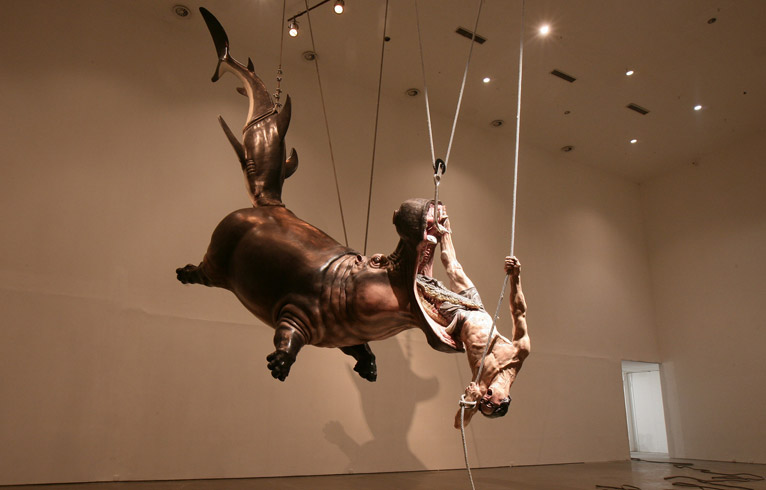CHEN WENLING – THE SUSPENSE
| March 11, 2011

Remember when you were a little kid and you’d take out all your toys and create fantastic stories about their relationships, pitting them against each other in epic battles? Chen Wenling certainly does. His recent exhibition is a highly emotional narrative on themes of conflict and domination, rich (as titularly promised) with the suspension of things—animals, time, disbelief, and justice, to name a few. Hanging from the ceiling of the cavernous space near the entrance is a scene from an epic battle: a fisherman, line in hand, has one leg buried waist-deep in a crocodile’s mouth, who in turn is being swallowed by a hippopotamus, who is shocked to discover a shark sinking its teeth into the former’s rear end. The fisherman’s line ropes them together, wrapping around the shark’s midsection, hooks digging into the hippo. The man holds on tightly at the other end. It’s quite the sight, and gives the immediate impression of action figures being slammed together by a small child, fighting for supremacy. But these figures are larger than life, so instead of being the omnipotent child we become a fly on the wall of some giant child’s room. This is no surprise coming from an artist who made his own toys because his parents were often unable to buy them for him.
The feeling of observing a child’s fantasies at play is repeatedly reinforced in this first room. Hippos are freshwater creatures, while sharks live in the sea; the odds of these creatures meeting are scarce. And then there’s the shark, chomping into the hippo, and the clear look of surprise in the hippo’s eyes as it turns back to face the attacker. The man is muscle bound in a way immediately recognizable to anyone who’s ever played with action figures: he’s like a G.I. Joe, and bears more than a passing resemblance to the artist. The effect is almost silly. It’s remarkably large, and delightfully funny, but only for so long, because these figures are inflicting brutal damage on each other. There is blood—lots of it—broken teeth, and torn flesh. The fishing line falls to the floor in bloody piles, wanders from a wall across the room, then around the corner and out of sight. There is a total lack of distance between the work and the viewer—the bulk of the piece is suspended at least two meters in the air, while the fisherman’s line darts across the floor and eventually out into another space.
Chen Wenling begs you to walk around, underneath, and through his work, immersing you in his trippy nightmare. But things quickly take a turn as we are presented with a photograph on the wall. It’s a crime scene, the place where Chen and his wife (then girlfriend) were robbed and brutally stabbed in 1996, and it’s horrifying. Blood is everywhere. Underneath the photo, Chen’s emotionless, matter-of-fact explanation is written on the wall. Suddenly the fun, childlike fantasy is over; this really happened. The line continues around another corner. Following it we find the aftermath—the crocodile, shark, and hippopotamus, all belly-up, all smaller and more real now, blood dripping from wounds and open mouths. The juxtaposition of sobering photograph and lifelike animals emphasizes how real and brutal this moment was. In the end, we’re truly left in suspense. Bloody footprints follow the fisherman’s line out a door into blackness; handprints on the wall suggest his struggle to keep upright and move forward. Did he survive or simply wander off to die alone? Assuming the fisherman is Chen, he has survived and then some. Exhibition materials tell us that he is establishing the “Suspense Foundation” to educate the children of his attacker’s village, and is searching for the third man in order to forgive him. Follow the line, Chen seems to say, and remember what it’s like to create fantasies in an attempt to control our violent, scary world. Angus McDougal

